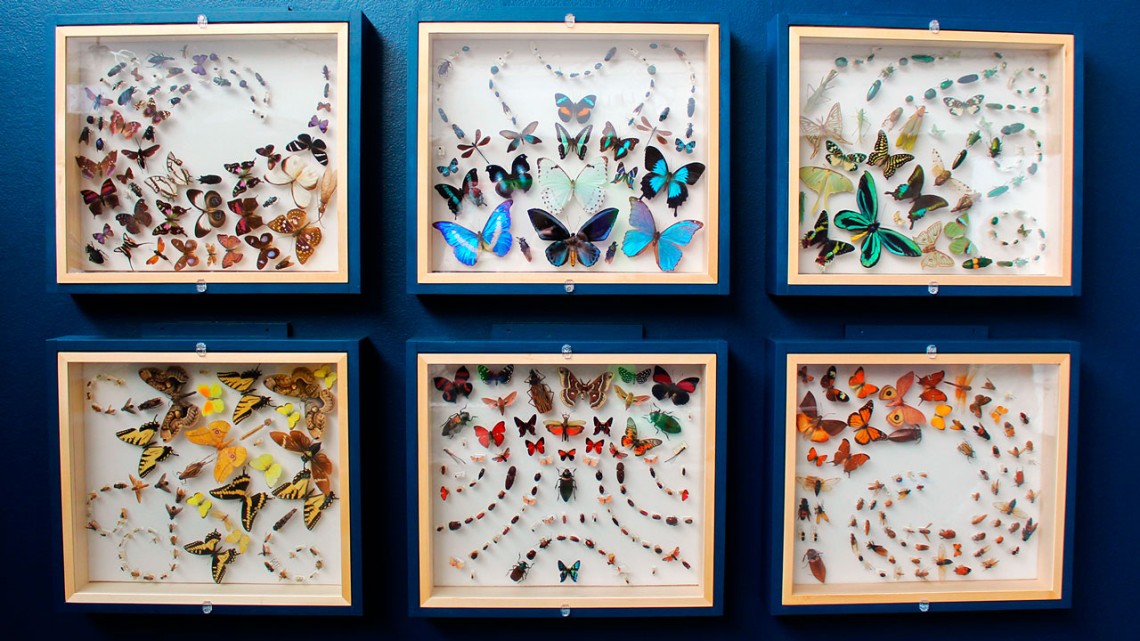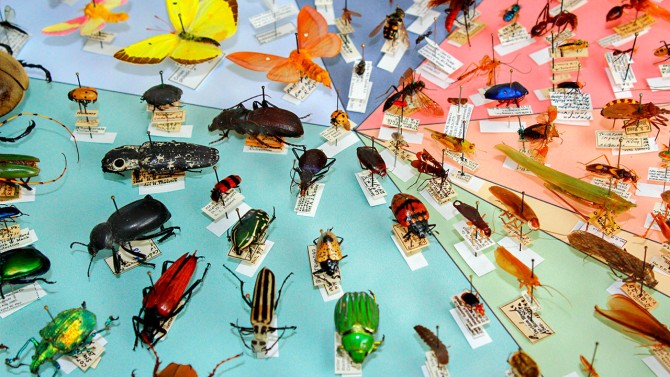
Six insect displays from the exhibit arranged by color highlight insect beauty and diversity.
Bugged out! Exhibit displays insect diversity and importance
By Krishna Ramanujan
Insects are by far the most diverse group of animals on the planet, with more than 1 million estimated known species, and many millions more that have yet to be named. A 2018 study estimates there could be as many as 14 million total insect species.
An exhibit at the Paleontological Research Institution’s (PRI) Museum of the Earth in Ithaca – created in collaboration with Cornell entomologists and displaying approximately 1,000 specimens from the world-renowned Cornell University Insect Collection (CUIC) – offers a fascinating education in the diversity of insects and their importance to life on Earth.
A visit to the exhibit, “Six-Legged Science: Unlocking the Secrets of the Insect World,” which opened March 28 and will continue through the end of the year, provides visitors with a small slice of CUIC’s research collection of 7 million specimens and 200,000 species.
Displays offer examples of biomimicry, an evolutionary trick to conceal a bug’s true identity, including flies, beetles and moths that to an untrained eye appear indistinguishable from bees, or butterflies that look exactly like leaves, or beetles that resemble... feces.
There are giant insects such as the white witch moth, with a wingspan of up to 12 inches, and the Goliath beetle, which is more than 4 inches long.
One panel reveals a breadth of moth and butterfly species from New York state, which boasts 3,000 confirmed species, though there are likely 1,000 more yet to be identified.
“I think that [some] people tend to think of the five most commonly encountered insects and think that represents everything, and it’s so far from the truth,” said Corrie Moreau, CUIC director and the Martha N. and John C. Moser Professor of Arthropod Biosystematics and Biodiversity. Moreau designed the exhibit with Jason Dombroskie, CUIC manager and coordinator of the Insect Diagnostic Lab, and Helaina Blume, PRI’s director of exhibitions.
Despite all this diversity, insects are declining at astonishing rates, with entomologists warning of an insect apocalypse.
As one panel states, some entomologists have estimated that we’re losing about 10 to 20% of all insects every decade, due to habitat loss, pesticides, invasive species, urbanization, pollution and climate change. “Insect declines are due to a death by a thousand cuts,” Moreau said.
The exhibit highlights the importance of insects to people and life on earth, in both positive and negative ways. While some insects spread disease and damage crops and infrastructure, others provide invaluable ecological and agricultural services, including pollination and food sources to animals (and people in many parts of the world).
“I’d want this exhibit to reduce the number of people that pass by an insect and say, ‘that’s just a bug’,” Dombroskie said. “I’d want them to be able to associate a story to that, to see how important that insect is.”
As a takeaway, the exhibit offers ways that individuals can help, including educating themselves about insects; shrinking their lawns, which provide poor habitat; using more native plants when landscaping; limiting pesticide use; turning off unnecessary outdoor lights that adversely affect nocturnal insects; and fighting climate change. “We’re hoping visitors walk away knowing that they can do something in their own backyards to help insects in decline,” Blume said.
The wide array of panels and displays include: evolutionary history; fossils; descriptions of the CUIC, its importance to research, and information on the insect diagnostic lab where specimens are identified; a glimpse into insect research; anatomy and life cycles; a section on relationships between insects and society; and insects and climate change.
Funded by the National Science Foundation, other features include 14 interactive videos and terrariums of live ants, cockroaches and beetles. The exhibit can also be viewed online.
Get Cornell news delivered right to your inbox.
Subscribe

